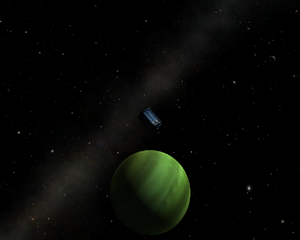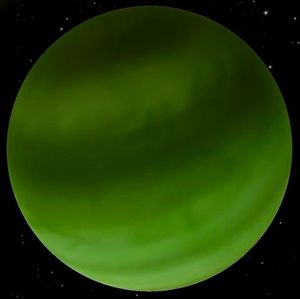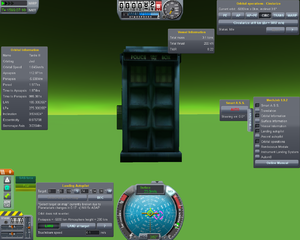Difference between revisions of "Jool"
m |
(Removing locations transclusion.) |
||
| Line 49: | Line 49: | ||
Closer to the surface, the physics of the game start to break down. Due to its extremely thick atmosphere, terminal velocity is so low that lighter spacecraft will not even need parachutes or retrorockets. It is not impossible to land on it's solid surface, though spacecraft are inevitably and invariably devoured by the [[Kraken]]. If a kerbonaut is put on EVA he will not be destroyed, making long term landings feasible. | Closer to the surface, the physics of the game start to break down. Due to its extremely thick atmosphere, terminal velocity is so low that lighter spacecraft will not even need parachutes or retrorockets. It is not impossible to land on it's solid surface, though spacecraft are inevitably and invariably devoured by the [[Kraken]]. If a kerbonaut is put on EVA he will not be destroyed, making long term landings feasible. | ||
| − | |||
| − | |||
== Natural Satellites == | == Natural Satellites == | ||
Revision as of 14:31, 23 September 2012
Jool is a gas giant and the fifth planet of the Kerbolar star system.Characteristics
- Equatorial Radius: 6000 km
- Mass: 4.236e24 kg
- Density: 4.68 g/cm³
- Surface Gravity: 7.84 m/s² (0.8 Gs)
- Gravitational parameter: 2.8254e14 m³/s²
- Escape velocity from surface: 9704 m/s
- Sidereal Rotation Period: ... hours; Rotation: ... degrees per hour, or ... m/s at the equator
- Solar Day: ... hours, or ... hours, ... seconds.
- Synchronous Orbit altitude: ~7000 km; Stationary Orbit velocity: ... m/s
Orbital Characteristics
- Semi-Major Axis: 6.87e10 m or 0.46 Astronomical Units (A.U.)
- Eccentricity: ...
- Inclination: 1.3°
- Velocity: ... m/s
- Argument of Periapsis: ...°
- Mean Anomaly at Epoch UT = ...
- Orbital Period: ... hours, or ... Earth days
- Sphere of influence: 2,455,985 km, or 409 body radii.
Atmosphere
Although Jool has a radius ten times greater than Kerbin, its atmosphere begins approximately twice as high (138.2 km). It is also extremely dense, well suited for aerobraking from a high-speed inter-planetary intercept.
Closer to the surface, the physics of the game start to break down. Due to its extremely thick atmosphere, terminal velocity is so low that lighter spacecraft will not even need parachutes or retrorockets. It is not impossible to land on it's solid surface, though spacecraft are inevitably and invariably devoured by the Kraken. If a kerbonaut is put on EVA he will not be destroyed, making long term landings feasible.
Natural Satellites
Jool has four natural satellites:

- The ocean moon Laythe, which has an atmosphere and is both the largest and closest to Jool. Due to it's high orbital velocity, it is somewhat challenging to reach.
- The ice moon Vall, which is the second largest and second closest. It's orbital path and velocity sit almost exactly between Layth and Tylo.
- The rocky moon Tylo, similar to Kerbin's Mun, is the third body orbiting Jool. It is perhaps the easiest of the four to reach, with a stable orbit, large gravity well, and (relatively) slow orbital velocity.
- The captured asteroid Bop, the smallest body orbiting Jool. Due to it's distant, erratic orbit and low gravity, it is also challenging to reach.
Laythe, Vall, and Tylo are in a Laplace resonance, with orbital periods of 1:2:4 respectively.



